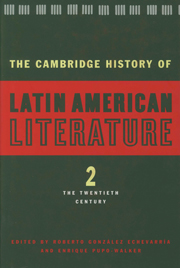Book contents
- Frontmatter
- Introduction to Volume 2
- 1 Modernist poetry
- 2 Modernist prose
- 3 The Vanguardia and its implications
- 4 The literature of Indigenismo
- 5 Afro-Hispanic American literature
- 6 The Criollista novel
- 7 The novel of the Mexican Revolution
- 8 The Spanish American novel from 1950 to 1975
- 9 The Spanish American novel: recent developments, 1975 to 1990
- 10 Spanish American poetry from 1922 to 1975
- 11 The modern essay in Spanish America
- 12 Literary criticism in Spanish America
- 13 The autobiographical narrative
- 14 The twentieth-century short story in Spanish America
- 15 Spanish American theatre in the twentieth century
- 16 Latin American (Hispanic Caribbean) literature written in the United States
- 17 Chicano literature
- Index
- Bibliographies
- References
17 - Chicano literature
Published online by Cambridge University Press: 28 March 2008
- Frontmatter
- Introduction to Volume 2
- 1 Modernist poetry
- 2 Modernist prose
- 3 The Vanguardia and its implications
- 4 The literature of Indigenismo
- 5 Afro-Hispanic American literature
- 6 The Criollista novel
- 7 The novel of the Mexican Revolution
- 8 The Spanish American novel from 1950 to 1975
- 9 The Spanish American novel: recent developments, 1975 to 1990
- 10 Spanish American poetry from 1922 to 1975
- 11 The modern essay in Spanish America
- 12 Literary criticism in Spanish America
- 13 The autobiographical narrative
- 14 The twentieth-century short story in Spanish America
- 15 Spanish American theatre in the twentieth century
- 16 Latin American (Hispanic Caribbean) literature written in the United States
- 17 Chicano literature
- Index
- Bibliographies
- References
Summary
How can the inclusion of a section on Chicano literature in a history of Latin American literature be justified? In order to answer that question it is necessary to examine briefly two topics, the nature of national literature and the nature of Chicano literature itself. Regarding the first, it can be observed that in the field of literary criticism there are two extreme positions: one that denies the existence of a national, regional, or ethnic literature; and another that accepts that concept. Renée Wellek and Austin Warren, in their book, Theory of Literature dedicate a chapter to a discussion of “General, Comparative, and National Literature”, in which they state:
“The term “world literature,” a translation of Goethe’s Weltliteratur, is perhaps needlessly grandiose, implying that literature should be studied on all five continents, from New Zealand to Iceland. Goethe, actually, had no such thing in mind. “World literature” was used by him to indicate a time when all literatures would become one. It is the ideal of the unification of all literatures in one great synthesis, where each nation would play its part in a universal concert. But Goethe himself saw that this is a very distant ideal, that no single nation is willing to give up its individuality. Today we are possibly even further removed from such a state of amalgamation, and we would argue that we cannot even seriously wish that the diversities of national literatures should be obliterated. ” (Harcourt, 1956: 37)
The same could be said about regional and ethnic literatures, and even for those written in a language other than the national language of a given country. In reference to the study of Medieval English literature, Wellek and Warren state that “A history of literature during the Middle Ages in England which neglected the vast amount of writings in Latin and Anglo-Norman gives a false picture of England’s literary situation and general culture” (p. 40).
- Type
- Chapter
- Information
- The Cambridge History of Latin American Literature , pp. 557 - 586Publisher: Cambridge University PressPrint publication year: 1996

